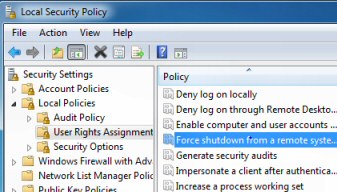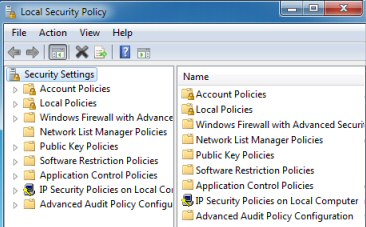Windows 7 Secpol.msc Local Security Policy
You can inspect and control the security settings with a snap-in called secpol.msc. Think of this built-in Windows utility as a sub-set of gpedit.msc.
Windows 7 Secpol Group Policy Review
- Windows 7 Group Policy Strategy
- Launch Windows 7 Secpol.msc
- Problem Cannot Find the Windows 7 Gpedit.msc
- Sample Group Policy Settings
- Windows 7 Secpol Case Study
- Windows 8 Secpol
- Storing Windows 7 Group Policies
♦
Windows 7 Group Policy Strategy
If you have Active Directory then you will probably control group policy strategy via GPMC on the domain controller. However, if you are responsible for Windows 7 in a Workgroup or HomeGroup then you will choose the local security policy editor – secpol.msc.
Launch Windows 7 Secpol.msc
When you want change a security setting this is how you launch the Local Security Policy Editor.
- Click on the Start orb, and in the search dialog box type: secpol.msc
Note: Most people forget to type the .msc file extension, consequently nothing happens. - When secpol.msc appears in the search results, consider creating a shortcut by right-clicking and choosing either ‘Pin to Taskbar’, or ‘Pin to Start Menu’.
- Navigating through the security settings is as easy as finding files and folders with Windows Explorer.
- A good place to start your exploration is in the Local Policies, Security Options.
Problem: Cannot Find the Windows 7 Secpol.msc
A common problem is that even if you follow the above instructions correctly Windows 7 still cannot find secpol.msc. The most likely cause is that you have the Home Premium edition. It’s most disappointing that you only get secpol.msc in the Ultimate, Professional (old Business) and Enterprise editions, and not in the Windows 7 Home Premium or Basic editions.
Guy Recommends: A Free Trial of the Network Performance Monitor (NPM) v11.5
v11.5
SolarWinds’ Orion performance monitor will help you discover what’s happening on your network. This utility will also guide you through troubleshooting; the dashboard will indicate whether the root cause is a broken link, faulty equipment or resource overload.
What I like best is the way NPM suggests solutions to network problems. Its also has the ability to monitor the health of individual VMware virtual machines. If you are interested in troubleshooting, and creating network maps, then I recommend that you try NPM now.
Download a free trial of Solarwinds’ Network Performance Monitor
Windows 7 Secpol Case Study
How To Stop Psycho Remotely Shutting Down Computers
Scenario
If you are running a training session and the delegate from hell keeps shutting down other students machines by abusing shutdown -s or -r.
Solution: configure a security policy to prevent ‘Force Shutdown From a Remote Machine’.
Launch GPMC or SECPOL.MSC
Navigate to Local Policies, User Rights Assignment.
Seek ‘Force shutdown from remote system’.
Experiment by assigning just your account, rather than all administrators.
Storing The Windows 7 Group Policies
Windows 7 Group Policies, created by secpol.msc are stored in a special hidden folder
%SystemRoot%\System32\GroupPolicy\
Actually there are two sub-folders where you will find the registry.pol files:
..\GroupPolicy\Machine and …\GroupPolicy\User. This name of these files remind us that virtually all group policy settings affect settings in the registry.
Incidentally, the environment variable %SystemRoot% usually translates to C:\Windows.
Summary of Windows 7 Secpol.msc – Local Security Editor
Microsoft supplies a Local Policy Editor so that you can change security settings without resorting to regedit. If you are familiar with gpedit.msc, then secpol.msc is a subset.
If you are troubleshooting gpedit.msc in Windows 7 Home Premium, it does not exist; you need to upgrade to the Ultimate edition.
If you like this page then please share it with your friends


